A Golden Vimanam
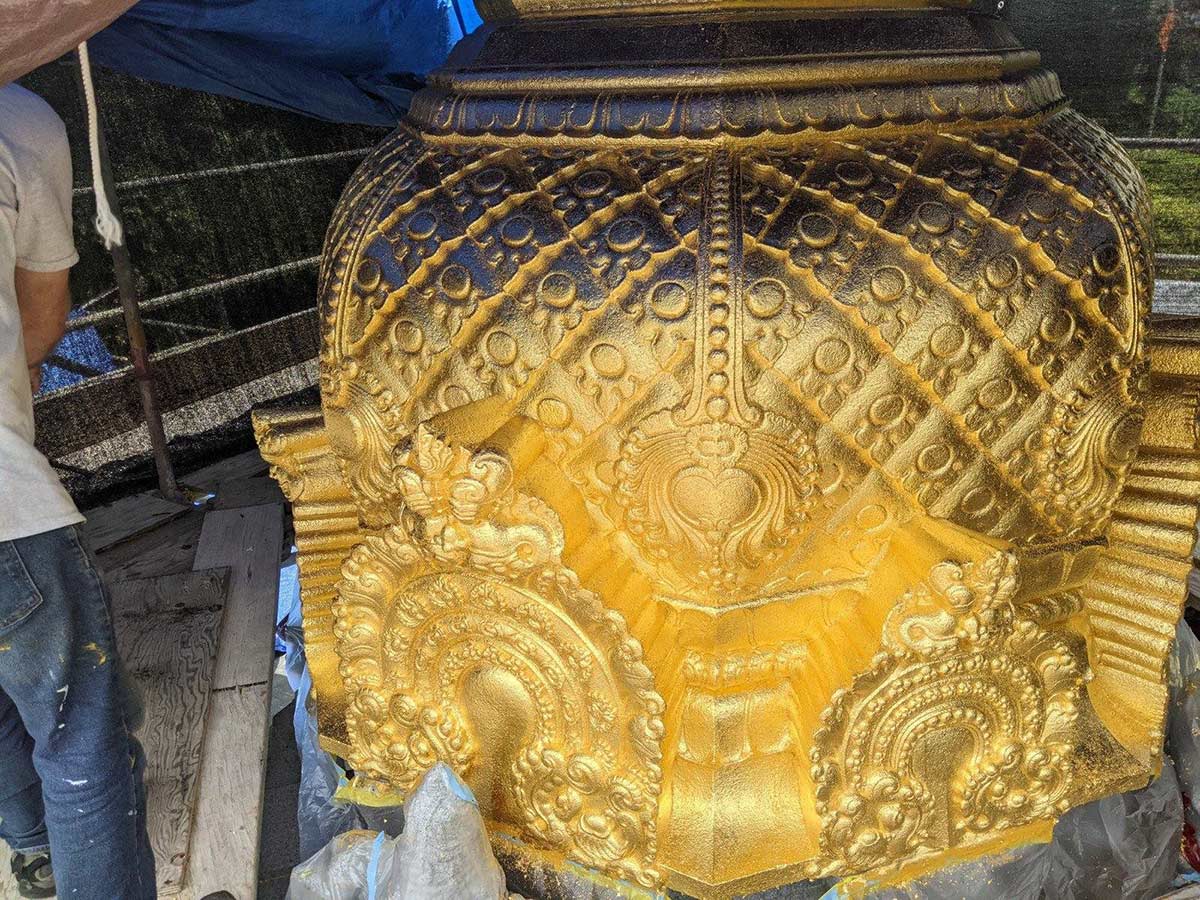
Aum Namah Sivaya
Here’s a sneak peak at Iraivan Temple’s newly regilded golden vimanam. The Vimanam is a Hindu Temple’s tower or roof-structure which rises over the central sanctum. It is this capstone over which the divinity-infused kumbha (water pot) gets poured during the temple’s Kumbhabhishekam, its consecration ceremony. Aum.
Let the Panchakshara Shine!
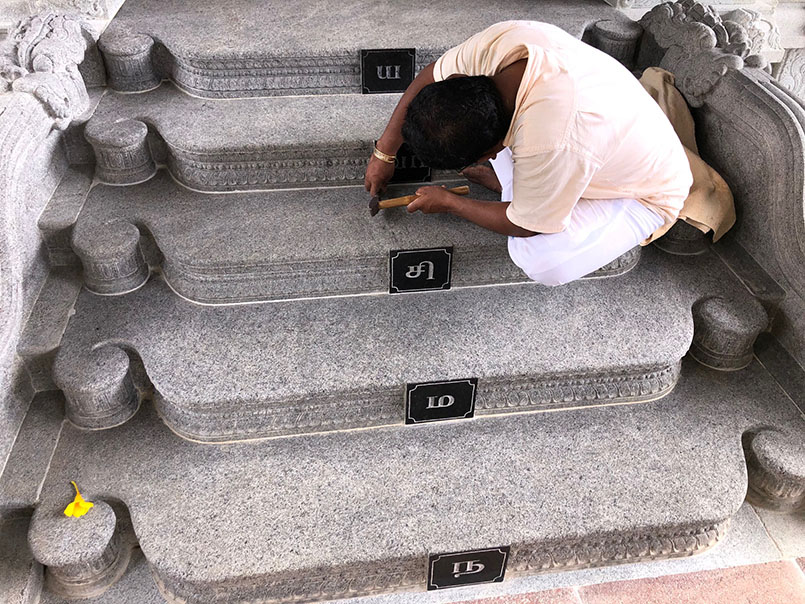
Aum. Recent progress on Iraivan Temple has included many little projects by the silpis, including a good deal of work to ensure the waterproof longevity of several misbehaving roof joints. The gold gilding on the caps stones has also recommenced with Micheal and his team having recently arrived back on island (but more on that to come). This week, Adaikalam has been finishing up his task of polishing the Panchakshara symbols on the steps which lead to Iraivan’s sanctum. As you can see these dark “Na Ma Si Va Ya” squares now have greater contrast and visibility. This last layer of chiseling, using something of a “sand-paper” like chisel tip, can be vary time consuming, but the results are always astonishing.
Kodimaram Welding
Today we find Sannyasin Yoginathaswami brushing up on his welding skills in our machine shop. He's working on a part of Iraivan Temple's kodimaram that was in need of further welding. This ornamental piece runs at a diagonal from the top of the flagpole to the underside of the lowest flag section. While the ingenious structure of the flag pieces ensures that they stay horizontal, this piece still gives some added stability. When we received it, it was held together with tack welds, so Yoginathaswami has spent several days applying full welds to each joint.
Final Steps of Iraivan Temple’s Kodimaram
Aum Namah Sivaya
This week the monks of the Siddhidatta Kulam and the siplis worked on the final installation of the kavacham (metal cladding) on Iraivan Temple's kodimaram—the temple's flagpole. Each piece of the kavacham must go over the tall piece of teak wood in the correct order. They then have to be set in place with wooden spacers to properly attach around the pole. The top of the pole is etched with three progressively smaller edges over which sits the three pieces of the metal "flag." The flag is a complex and ancient design, which once put together with its bracing pieces, is almost completely without any sagging. Mind you, these are 8-foot long, horizontal pieces attached to a top of a pole. They are also very heavy. A rather astounding example of Indian temple engineering. With all the kodimaram pieces installed, our gold leafing team can soon work their magic. Aum.
Scaffolding for Iraivan Temple’s Gold

Aum Namah Sivaya
Recently the aadheenam received a large shipment of scaffolding for the upcoming gold leafing work to be done on the temple's capstones. As we've mentioned in our newsletters, on their original installation these capstones were a little under prepared for our intense tropical weather, resulting in quicker wear and in the growth of molds and lichen. Due to this, we're having the company that does the gold work on our nation's capital buildings come out to do a more lasting installation for the temple. This work will also include the kodimaram for Iraivan Temple and some touch up work on Kadavul Temple's kodimaram as well. This week the scaffolding was fully set up and the temple is now ready for the gold work to begin.
Before and After – Temple and Nandi Mandapam
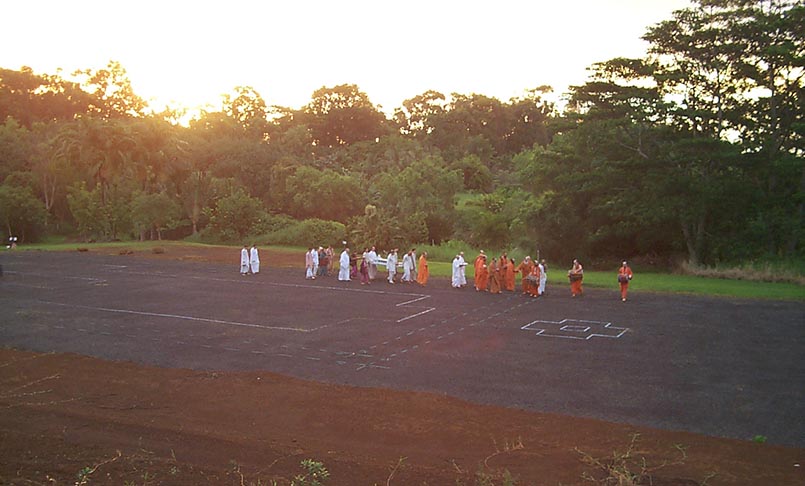

Aum Namah Sivaya
Here we bring you another fascinating before and after shot of Iraivan Temple's creation.
Foundation Pour Then and Now
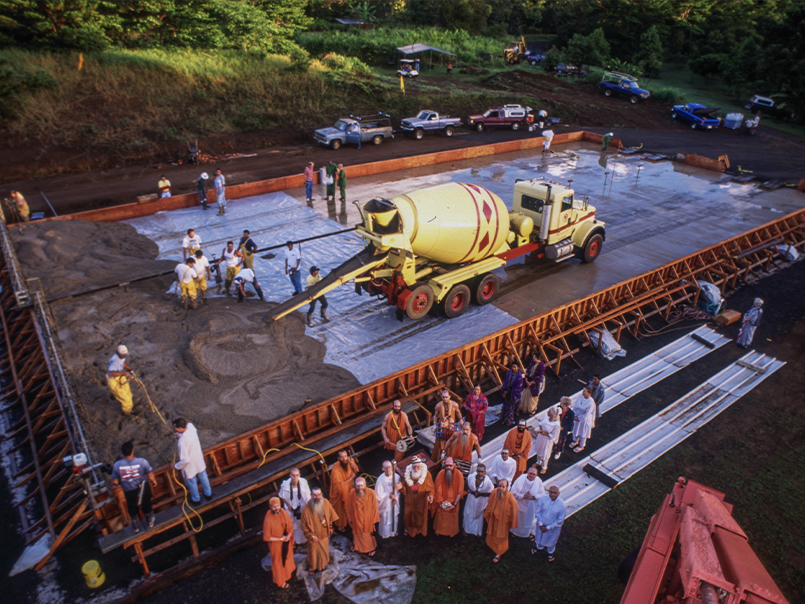
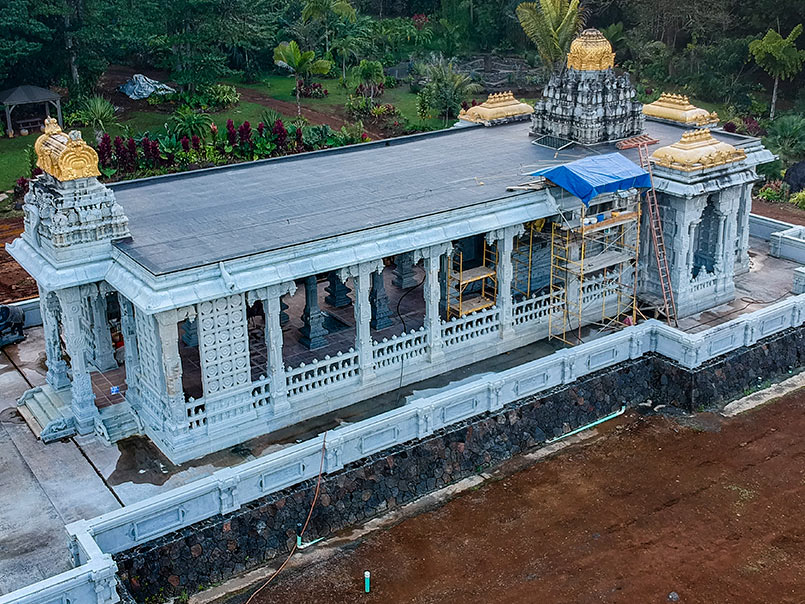
In August of 1999 the foundation of Iraivan temple was poured. At the time, the lead engineer exclaimed: "This hasn't happened for 2,000 years! It's historic. Not since the Greeks and Romans has such a massive placement of concrete been completed without a single crack. Not even a hairline fissure." Dr. Mehta's joy spread throughout Kauai's Hindu Monastery and the island. The 117' 6" by 56' by 4' foundation weighs over 4 million pounds and took exactly 108 cement trucks to place. Founder and Satguru Sivaya Subramuniyaswami, who had declared it must last 1,000 years, now knew that it would.
This pioneering project was made of a special mix that reduces Portland cement about 40% and replaces it with the pozzelon coal fly ash. Dr. Mehta noted that this makes a superior concrete, stronger, more durable, harder and even cheaper. It's adoption by nations and industries could radically reduce the greenhouse global warming problem, for which cement production worldwide is responsible for an astonishing six percent.
Iraivan Temple’s Lava Rock Wall Completed!

Aum Namah Sivaya
Today we celebrate the completion of the stone laying for Iraivan Temple's lava rock wall! Jai!
There are still a few finishing touches, primarily the of staining grout joints, but the main wall structure is finished. Umut and his team have set the last stone, relocated the leftover stones, and deconstructed their tenting around the perimeter. Now we can all marvel at this wonderful addition which bring the temple ever closer to its completion. Aum.
Lavarock Wall Update – April 9th

Jai Ganesha!
Recently our masonry team, who has been building the lava rock wall around Iraivan Temple, has completed the rock laying on the north side of the foundation. They had already completed the east side which faces Rishi Valley. The North end of the temple faces Dakshinamurti, and with this section completed, the team is focused on completed the west side which is already quite far along. Aum.
A Sunny Day for Temple Tile Repair
Jai Ganesha!
After several weeks of grey cloud-cover and massive amounts of rainfall, today our monks have enjoyed a full day of bright sun and blue, rainless skies. The grounds are already beginning to warm up and the many well-watered plants are bursting at the seams with fruits and new growth. This is a perfect chance to work on the remaining tile-replacement around Kadavul Temple. While the area we'd been working on out front has been finished, the focus now turns to the temple-side path that leads to the small Ganesha shrine. While some tiles are cracked, many can be restored and reset. Aum.
From Our Gurus' Teachings
Archives are now available through 2001. Light colored days have no posts. 1998-2001 coming later.
